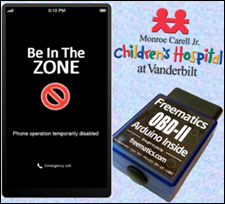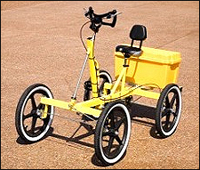Engineering seniors have spent two semesters tackling design challenges from actual clients with real design needs.
The results of their design projects will be featured at Design Day 2014, an annual School of Engineering event, Monday, April 21, 4-6 p.m. in Featheringill Hall.
Corporate sponsors this year include The Hershey Company, Camgian Microsystems, DENSO, General Motors, Nissan North America, Rhoads Car International, Northrop Grumman, Roche Diagnostics and Tyvak Nano-Satellite Systems. Other sponsors include NASA, U.S. EPA, a number of Vanderbilt University Medical Center departments and several area engineering firms.
More than 60 projects by interdisciplinary teams in biomedical engineering, chemical engineering, civil engineering, computer engineering, electrical engineering, engineering management and mechanical engineering will be displayed throughout Featheringill Hall.

“Senior design courses provide students with experience working on real-world projects that involve design constraints, budgets, reviews and deadlines. Students learn about professionalism, licensing, ethics, entrepreneurship and the day-to-day implications of intellectual property,” said Associate Dean Cynthia Paschal, who also serves as senior design coordinator. “This tradition is a culmination of their undergraduate education.”
 One interdisciplinary team is developing an Android mobile phone application that, when used in conjunction with a hardware device, blocks the driver’s ability to interact with the phone during predetermined high-risk driving times. The goal of the ‘anti-distracted driving device’ is to restrict teens from using their cell phones while driving.
One interdisciplinary team is developing an Android mobile phone application that, when used in conjunction with a hardware device, blocks the driver’s ability to interact with the phone during predetermined high-risk driving times. The goal of the ‘anti-distracted driving device’ is to restrict teens from using their cell phones while driving.
The project was inspired by the Teen Motor Vehicle Safety Program at the Monroe Carell Jr. Children’s Hospital at Vanderbilt, which is supported by The Allstate Foundation and Ford Motor Company Fund and Community Services.
Sponsored by The Hershey Company, a three-student team has designed a “proof of concept” device that will better identify flaws in the plastic film wraps of the company’s non-chocolate ‘confectionary’ products. “We’re working on the tubes of ice cubes – the cube-shaped gum,” the students said and laughed.
Using senior Khairul Kamarulzaman’s expertise with video cameras, William Yates and Nicholas Souder have built a standalone test unit with a web camera takes a continuous stream of photos. It measures the width of the plastic film as it travels through the testing apparatus. The measurement data is output to an onscreen monitor for real time inspection, as well as a final Excel document with the raw data for the entire film roll.
“An alarm will trigger should a defect be detected, and it can be viewed on the monitor,” said Kamarulzaman. The three mechanical engineering students will demonstrate their prototype at Design Day.

Another design team is working on alterations to a Rhoades Car. A Rhoades car recently found itself in a media spotlight when England’s Prince Harry was photographed pedaling the “4-wheel bike that drives like a car” in the new Queen Elizabeth Olympic Park in east London.
Owners of the Hendersonville, Tenn., company asked the Vanderbilt design team to build a first-generation prototype with several improvements. Mechanical engineering professor Joel Barnett is helping the team build a light-weight model using carbon fiber developed by the Oak Ridge National Laboratory. The team also is designing the frame to disassemble, which would allow the quadricycle to be stored in the trunk of an SUV.
Students will install their presentations from 2-4 p.m. Several jurors will review the projects.
The work done in design is the intellectual property of the participating companies, which means legal negotiations are unnecessary. This allows collaboration with participating companies and students gain real-world experience. Teams meet with their clients to define the challenge, create a strategy, build a timeline, assign responsibilities, set deadlines and manage customer relations.
Students usually get to work on a project they prefer. “Occasionally, some get drafted,” said Barnett, associate professor of mechanical engineering and design faculty adviser. “If they end up working on something they don’t like at first or are unfamiliar with, well, we say, ‘Welcome to the real world of work.’”
“These projects often turn out to be some of the best, since the team is working in areas that are new to them,” he said.
Other 2013-2014 faculty advisers are Bob Webster, mechanical engineering; Matthew Walker III, biomedical engineering; Ken Debelak and Russell Dunn, chemical and biomolecular engineering; Sanjiv Gokhale, civil engineering; Ralph Bruce, electrical engineering; and John Bers, engineering management.